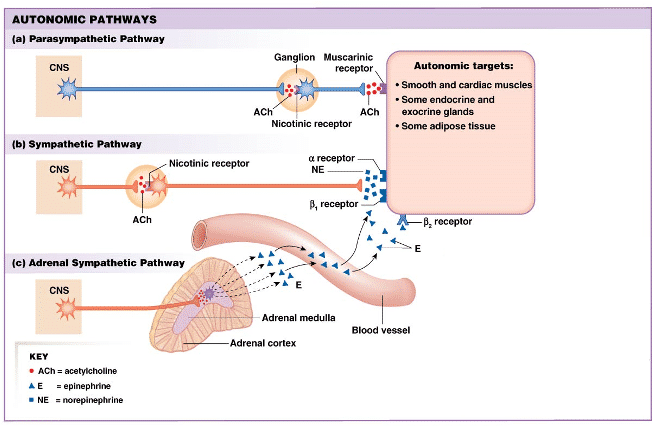autonomic nervous system
1/28
Earn XP
Description and Tags
lesson 4 unit 2 week 5
Name | Mastery | Learn | Test | Matching | Spaced |
|---|
No study sessions yet.
29 Terms
cns made of what and what is its function
brain - recieves and processes sensory info, initates response, stores memories and generates thoughts and emotions
spinal cord - conducts signals to and from the brain, controls reflex activities
pns made of
nerves that go from cns to muscles and organs like heart, liver, stomach
pns can be divided by
somatomotor - going to skeletal muscles to power voluntary movement
autonomic - going to other organs that are automatically controlled by brain and not under voluntary control
autonomic nervous systems effector neurons are called and compare to somatic nervous system
motor neurons bc they communicate an action unlike the somatic nervous system, that action is not skeletal muscle contraction
but it may be increase secretion of a gland (like salivary glands when u smell ur fave food u biggie)
or increased motility of ur intestine after a meal or decrease in heart rate at rest
pns neurons and function
motor neurons: cns to muscles and glands
sensory neurons: sensory organs to cns
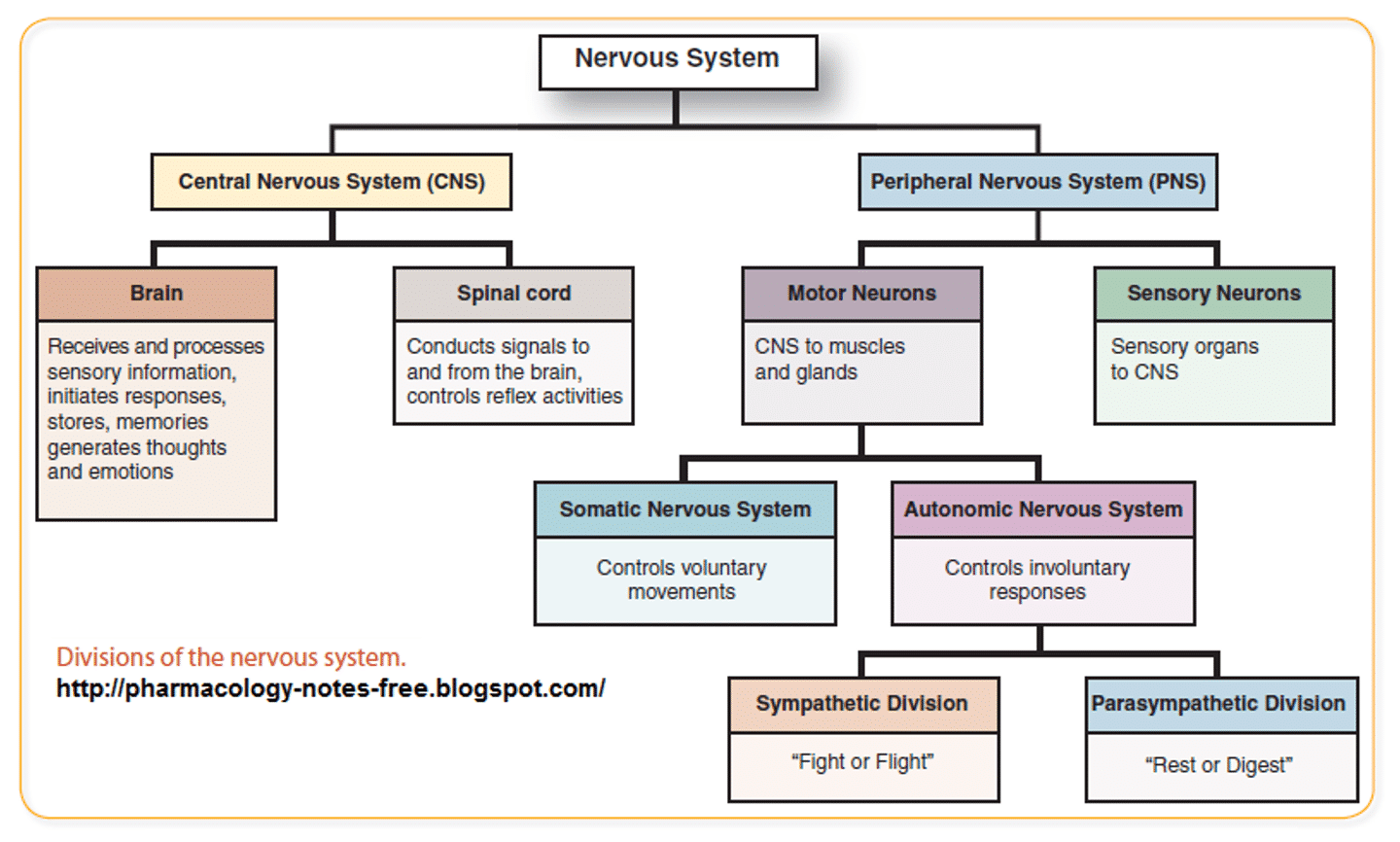
autonomic nervous system division
sympathetic - fight or flight
parasympathetic- rest and digest
sympathetic division (syn) of ans roles
responsible for activating body functions involved in fight or flight
when activated, it will increase ur heart rate + bp to get more blood to skeletal muscles
prepares them to either flee or fight; dilate ur airways to allow more air to get into ur lungs
and decrease blood flow and energy to the gut so it can be redirected to the muscles
also responsible for activating body functions associated with freeze situation where body is unable to move when confronted w/ stress
parasympathetic division (psyn) roles
responsible for storage and conservation of energy
functions associated with rest and relaxation
would slow heart rate and lower bp while directing blood flow twrds the gut to support digestion
when does the psyn and syn work together and not work together
some organs only have sympathetic innervation like adrendal glands and blood vessels
but in organs like genitalia, the two divisions work together to contribute to sexual arousal
function of psyn nerves thruout body
midbrain: constricts pupils
pons brain stem: stimulate saliva,
medulla: constrict airways, slow heart beat, stimulate activity of stomach, inhibit release of glucose, stimulate gallbladder, stimulate activity of intestines
sacral (s2-s4): contract bladder, promote erection and genital
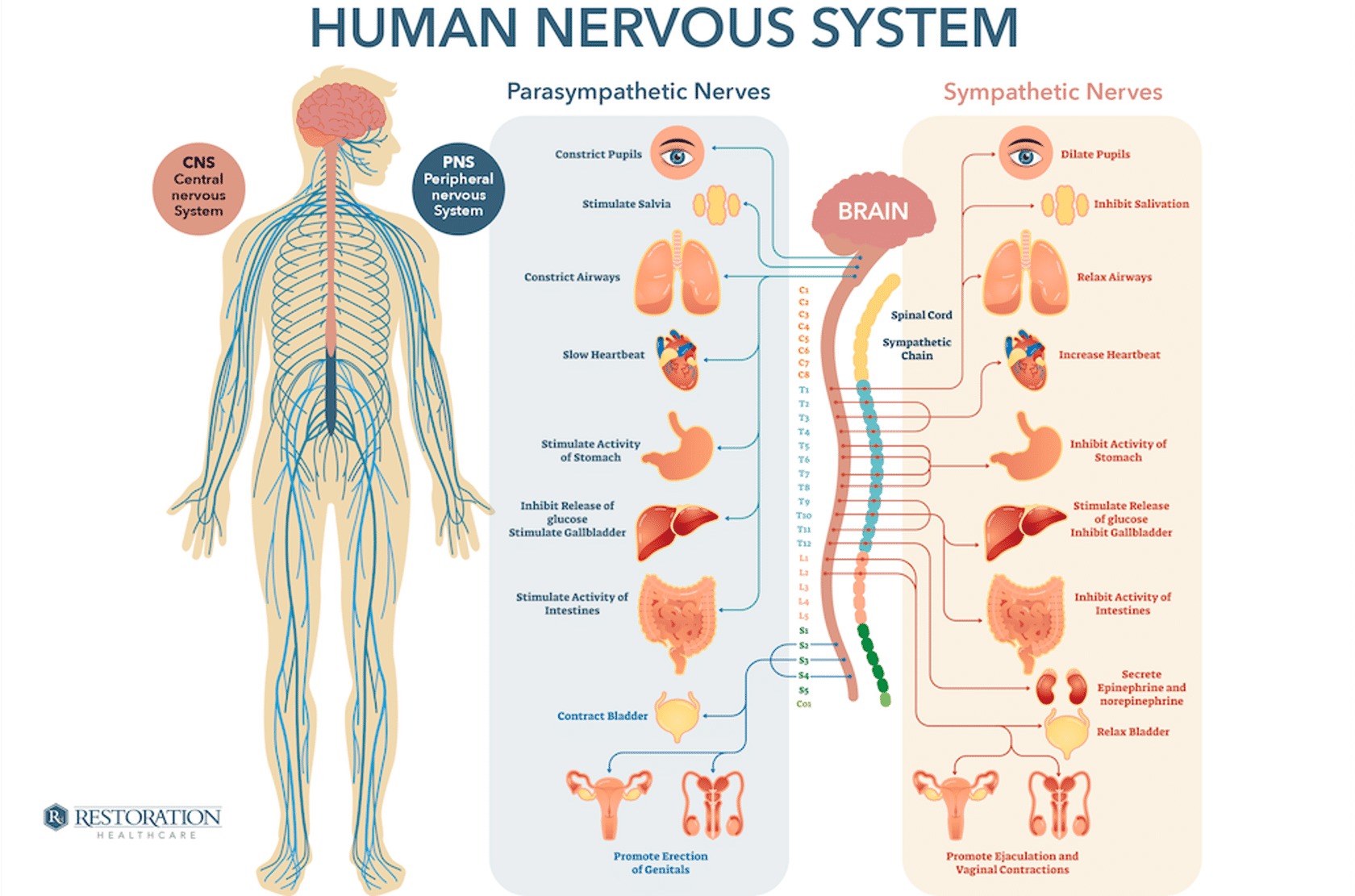
syn nerves thru out body
thoracic (t1): dilate pupils, inhibit salivation, relax airways
thoracic (t2-t4): increase heartbeat
thoracic: (t5-t8): inhibit activity of stomach
thoracic (t9-t11): stimulate release of glucose, inhibit gallbladder, inhibit activity of intestines
thoracic (t12): secrete epinephrine + norepinephrine
lumbar (L1-L2): relax bladder, promote ejaculation and vaginal contractions
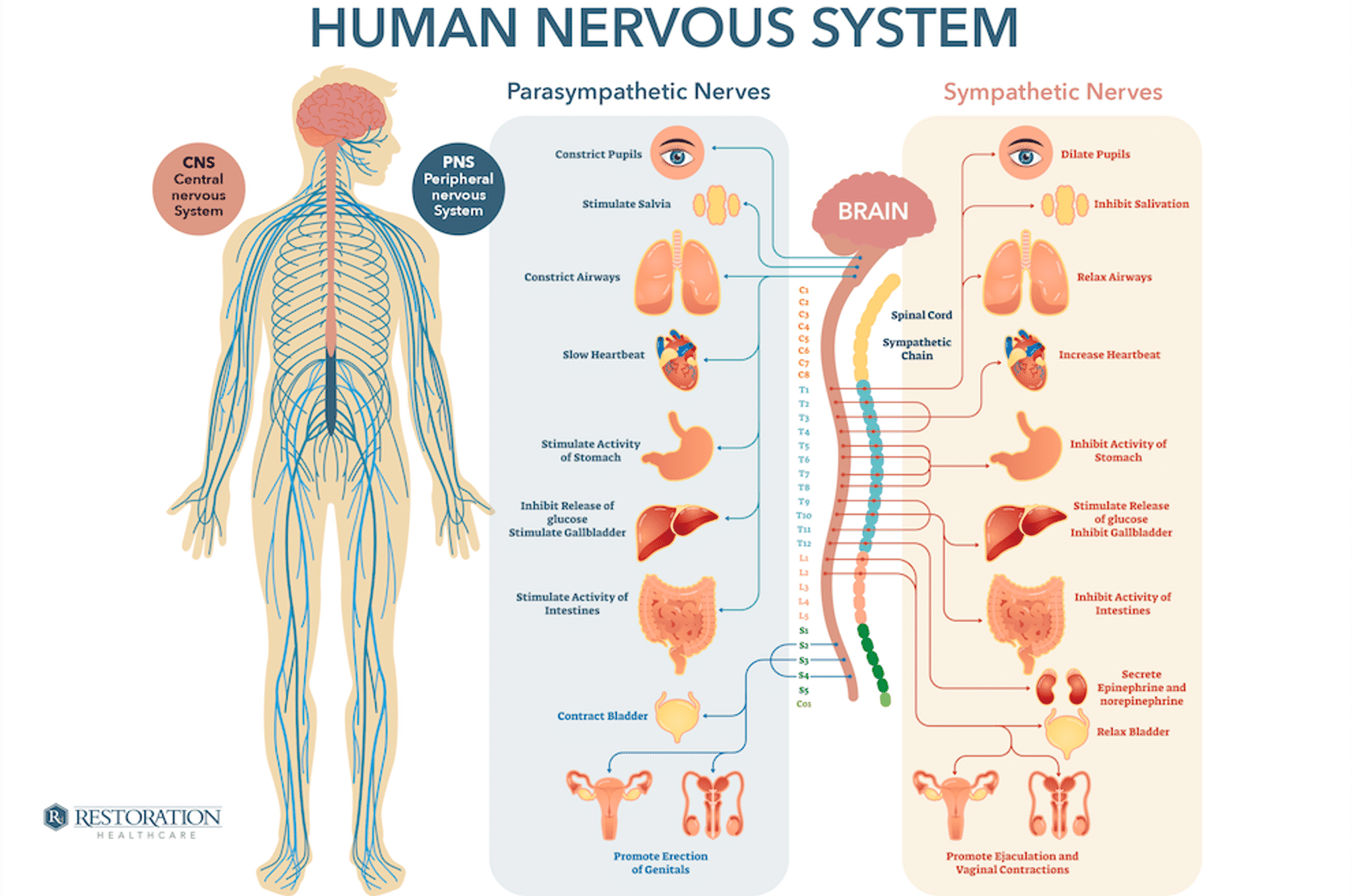
third division of ans
enteric nervous system - innervates ur gut and provides motility. Has ability to generate stimulation on its own, independant of innervation from cns.
ans role
controls hr, pupils of eyes, smooth muscle in walls of arteries and veins, glands and their secretions in the body, and many other organs
maintain homeostasis or a relatively stable internal environment
what monitors the internal environment for ans and what do they do
sensory receptors in viscera monitor internal environment
receptors send info back to cns thru afferent nerve fibers (afferent pathway)
info is integrated in the cns, where signals are interpreted by the hypothalamus (acting as control center)
hypothalamus makes a decision on the course of action and info is then sent from the cns to the effector organs or viscera
thru efferent nerve fibers (efferent pathway)
“decision” made by the hypothalamus may be sent down the syn/psyn pathway
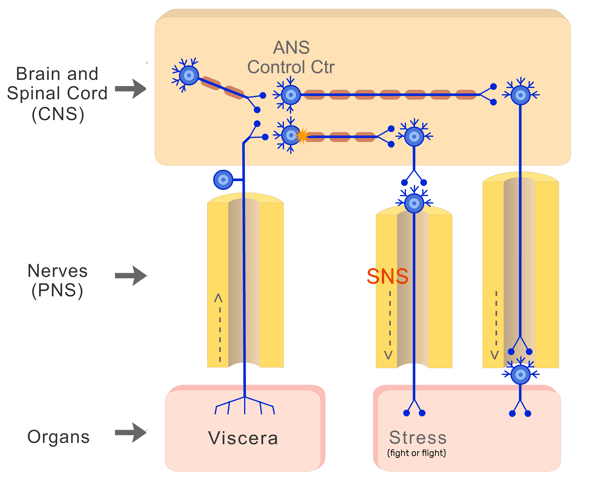
what does it mean when the hypothalamus decides not to go thru either the syn or psyn way?
they work together
so when one is more needed than the other,
signals are sent thru that route with higher freq
ex we wouldnt want to stop our breathing completely as we’re eating, just slow down so that we can eat in peace
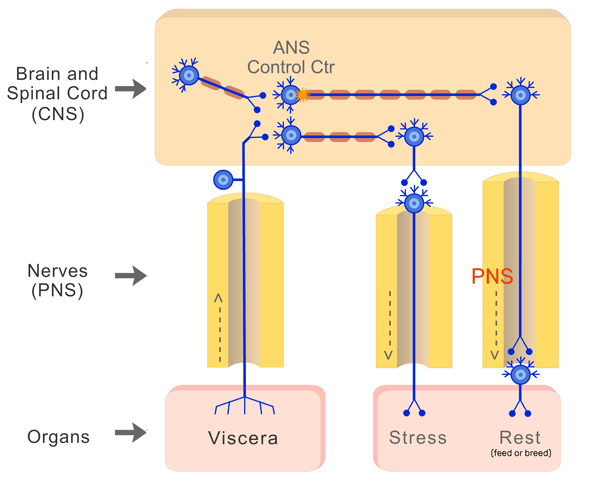
characteristics shared by neurons between the two pathways. preganglionic neuron, autonomic ganglion, and postganglioic neuron and target organ is described.
preganglionic neuron - both syn + psyn have this. they have their cell bodies in the cns
autonomic ganglion - both syn + psyn have it. its a group of nerve cell bodies that the preganglionic neuron synapses onto to relay info. allows for info to be relayed to multiple organs, increasing efficiency
postganglionic neuron - both syn and psyn have it. its cell body is located in the autonomic ganglion and synapses onto target organ
target organ - both syn + psyn send info to target organ
neurotransmitters
neurotransmitters in syn and psyn
both syn and psyn use neurotransmitters in the autonomic ganglion and at the target tissue to relay info
neurotransmitter in the autonomic ganglion is the same for syn and psyn
the neurotransmitters at the tissues are diff for syn and psyn
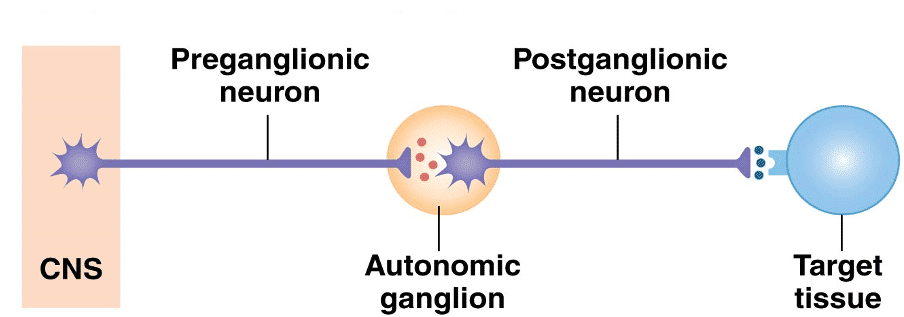
motor pathways of sympathetic division
nerves exit spinal cord in thoracic and lumbar regions
axon of preganglionic neuron is shorter
autonomic ganglion is closer to the cns
postganglionic neuron is longer and often myelinated
the main neurotransmitters at the target organ epinephrine and noradrenaline, w/ exception of sweat glands, where syn innervation releases acetylcholine
motor pathway parasympathetic division
nerves exit at the brain stem and lower sacral region of spinal cord
axon of preganglionic neuron is longer
autonomic ganglion is closer to target organ
postganglionic neuron is shorter and often unmyelinated
neurotransmitter at the target organ is acetylcholine
acetylcholine
preganglionic neurons that leave the spinal cord in both syn and psyn release acetylcholine at the autonomic ganglion
ACh binds to the nicotinic receptors located on dendrites of postganglionic neurons
that have their cell bodies in the autonomic ganglion
nicotinic receptors in autonomic ganglion is slightly diff from ones in nmj
fast transmission action of ACh
when ACh binds to the nicotinic receptors, it quickly causes them to open
ions rush in and depolarize the cell
ACh also binds to _____ also describe
muscarinic receptors
ligand gated/chemically gated receptor (needs ligand to biind to activate)
these receptors are not ion channels themselves
found on the target organs of ans - smooth and cardiac muscle cells
also called g-protein coupled receptors bc they activate g-proteins in the cell that open ion channels also called metabotropic receptor
when ACh binds to muscarinic receptors
when bound to ACh, they activate a series of biochemical rxns on cytoplasmic side of cell
which further activates and open ions channels in the post synaptic cell membrane
this process takes longer than opening of a nicotinic ion channel by the direct binding of ACh
this action of ACh is called slow transmission
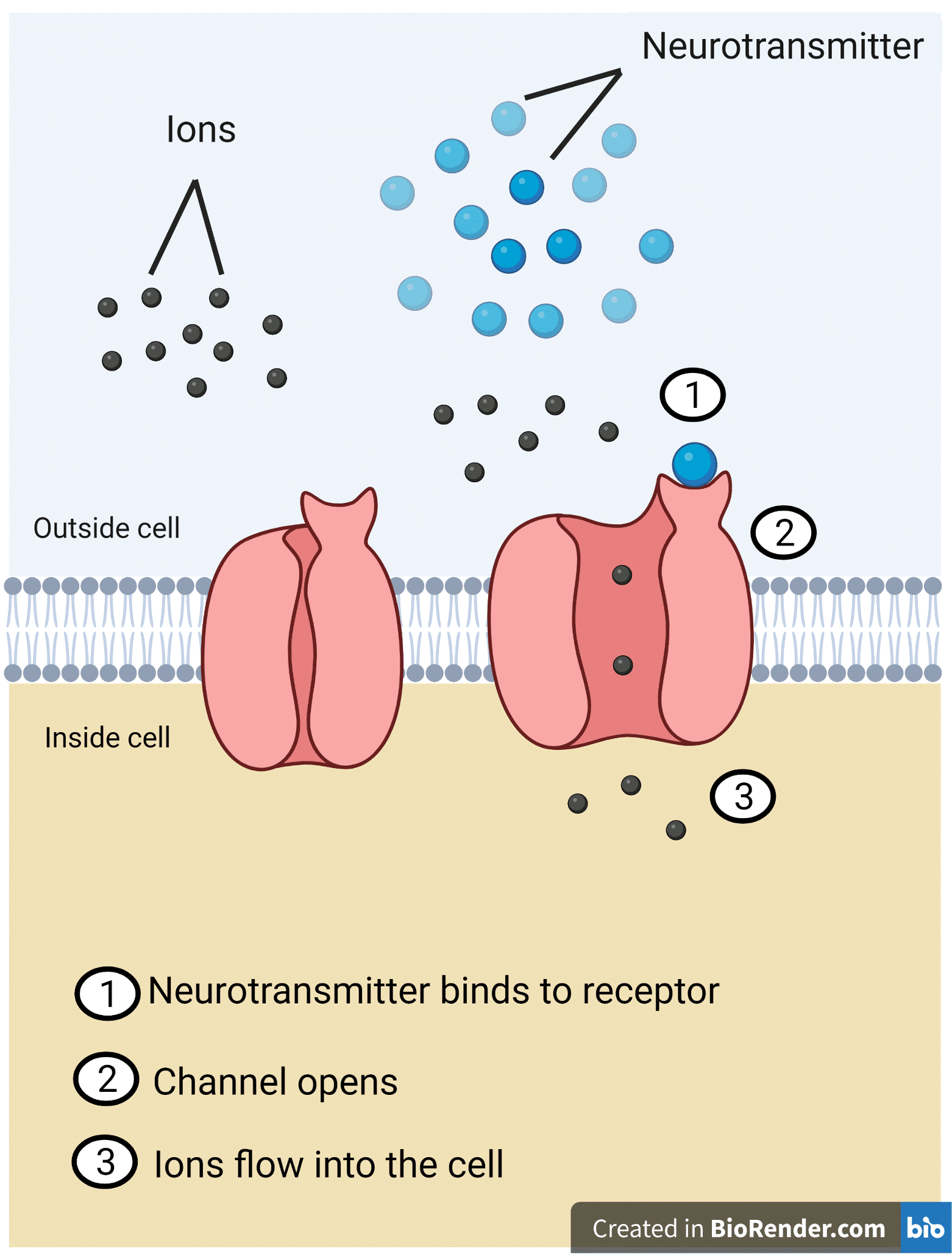
what happens to the signalling when ACh is released
syn and psyn signalling via release of ACh occurs thru ACh binding to muscarinic receptors on target organ
Nicotinic receptor
transmembrane receptor - meaning it spans the plasma membrane of the post synaptic cell
ligand-gated/chemically-gated receptor - also called ionotropic receptor
located at the nmj and at the post ganglionic cells of the vertebrate autonomic nervous system
norepinephrine
most signalling thru syn at target organ occurs thru norepinephrine (exception of sweat glands where ACh is released)
execption of adrenal glands as well 80% epinephrine produced and 20% norepinephrine
what are adrenergic receptors and types
receptors on target organs
two types: alpha adrenergic receptors and beta adrenergic receptors
alpha adrenergic receptors - smooth muscle contraction and vasoconstriction
beta adrenergic receptors - vasodilation, smooth muscle relaxation, bronhcodilation and excitatory cardiac function
adrenal gland exception of syn - describe
no psyn innervation
no postganglionic neuron
medulla acts as a modified autonomic ganglion
releasing epinephrine directly into the blood following excitation
draw autonomic pathways psyn, syn, adrenal
